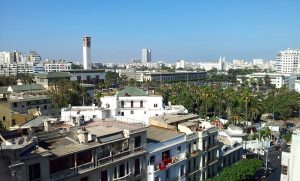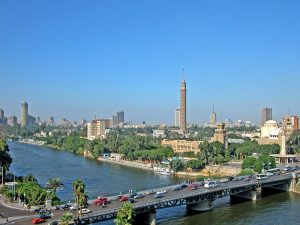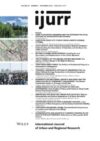Contemporary urbanization in North Africa is heavily weighed by the colonial legacy and the persistence of authoritarian rule that have plagued much of the independence period of countries in this region. Historically, cities such as Casablanca, Algiers and Cairo served as laboratories for colonial planning, which imposed modernist layouts and created dual cities divided along ethnic and class lines. Post-independence authoritarian regimes often inherited and repurposed these spatial configurations as well as the planning apparatuses that produced them. Thus, centralized modes of urban governance, the militarization and securitization of public space, the reduced possibilities for popular participation in shaping the future of cities, and resistance to these processes are dominant lenses through which the region’s urban experiences have been studied.
Given that this year the International Sociological Association Forum of Sociology, including the RC21 meeting, is held in Rabat (Morocco), IJURR is taking the opportunity to publish a virtual issue that brings a compendium of 10 articles and one book review exploring contemporary North African urbanization within the national contexts of Egypt, Tunisia and Morocco. Articles in this compilation appeared previously in our journal and now come to new life as a collection that will be available free of charge until the end of September 2025.

Railway Station. Rabat, Morocco
Within this collection, MacEwen Scott’s book review stands out: Published in the early 1980s, it covers Janet Abu-Lughod’s seminal Rabat: Urban Apartheid in Morocco, where the author explores the morphology of a segregated city along power and racial lines, and through the power of deliberate government policy, a legacy of French colonial rule that continues through the era of independence. In many ways, the book set the tone for future scholarship on Moroccan cities and beyond. Thus, we find echoes of its critical framework of public rule in recent analyses of resettlement programs (Beir, 2021; Portelli, 2024) and of the enduring legacy of colonial planning, particularly in its centralized form, in today’s Morocco (Rahmouni and Saizen, 2023).
More generally, the collection reflects the general themes around which urban scholarship about this region has coalesced, particularly questions of planning (centralized and failed), the population displacement it induces, urban informality, quiet and overt dissent, and the aspirations of populations under authoritarian neoliberalism.
First are critical reflections on urban governance, particularly practices of city planning in the shadow of colonial legacies and authoritarian rule, constantly producing specific mechanisms of city rule and planning. Given its largely informal urbanization and uncontrolled growth, Cairo is often associated with unruly urbanization. Two articles help us understand how authoritarian rule intersects with the production of such spaces. Harris and Wahba’s (2002) longitudinal study of Cairo’s largely informal urbanization provides a historical survey of the city’s extra-legal urbanization over a 50-year period. A decade later, Dorman’s (2013) investigation of Egypt’s failed land management plans for Cairo links the authoritarian structure of rule, the regime’s exclusionary nature, and the dominance of the Egyptian military to the form of exclusionary planning that has dominated Egyptian urban governance for decades. The author argues that Cairo’s largely uncontrolled growth is a result of its ruling political order, thereby highlighting the intersection of power structures, authoritarian rule, and the shape and form of urbanization.
Failed planning that produces splintered cities and creates new, potentially uncontrollable urbanization is also the focus of Beier (2021)’s critique of state-led housing programs in Morocco. Focusing on a shantytown resettlement in Casablanca, the study argues that a messy process of securing affordability through private actors and within a speculative environment produces a ‘splintered form of informality’ rather than the imagined ‘formal’ or ordered city.

“Au centre de Casablanca”. Picture by Maxim Massalitin is licensed under CC BY-SA 2.0.
Practices of city planning are also the topic of Rahmouni and Saizen (2023)’s article. By scrutinizing Morocco’s institutional framework of planning, the authors adopt a historical institutionalist lens to show how French colonial planning practices established during the French Protectorate (1912–56) introduced a highly centralized urban planning system that persists in Morocco’s postcolonial institutions, constraining decentralization reforms and paving the way for a dual planning system where powerful actors bypass official plans through systems of exception (derogation in French).
Conversely, themes of popular dissent, whether in the form of resistance to planning or small acts of encroachment and appropriation, have also produced a rich narrative about North African cities. An early and consequential piece in this collection is Bayat’s (2007) investigation of ‘slums and militant Islamism’. Examining comparatively the everyday decisions and acts of city dwellers in Egypt and Iran, Bayat argues that dissent is part of an informal politics of survival and self-development, showing how precarious populations negotiate their presence in the city through everyday pragmatic and contingent decisions rather than grand ideological stands (e.g. ‘radical’ Islamists). The article, which engages directly with a widespread trope that connects (to-date) the rise of Islamic movements to poverty, relocates instead the actions of ordinary urban inhabitants within strategies to negotiate and subvert authoritarian controls through what he calls ‘quiet encroachment’—informal spatial appropriations that fly under the radar of the state.
The theme of a negotiated and contested presence extends across the virtual collection, with examples from Moroccan and Egyptian cities, where forced displacements induced by planning projects have characterized much of housing policy, particularly since the neoliberal turn of the 1990s (Beir, 2021; Portelli, 2024). These forms of urban contestation, the modalities of dissent they generate, and the types of activism and struggles over public spaces they produce, formed the bulk of the literature on urban contestation in the region (see Elwageeh et al., 2024 in this collection).
Nevertheless, overt protests are also included through one article that examines critically the period of the Arab Spring (2011), a moment when tens of thousands of people, sometimes more, demonstrated across cities in the region to demand political reforms, social justice, and an end to corruption. Focusing on the Tunisian revolution, Zemni (2017) provides a background to neoliberal restructurings, hence tracing back the socio-spatial roots of the Tunisian revolution. His article then chronicles events that brought together members of different social classes, groups, and movements to coalesce against authoritarian rule in early 2011. Other articles published by IJURR outside this Virtual Issue further address urban contentious politics, comparing the Arab Spring and social movements across the Arab Middle East and providing additional insights into this unique moment for the larger region (Merrifield 2012; Turam 2013; Dikeç and Swyngedouw 2017).
Finally, a more recent current in the literature explores strategies to find ‘a semblance of inclusion’ for excluded middle classes who aspire to particular imaginaries of belonging. Two pieces in this collection fall squarely within these trends. Pettit (2018)’s study of aspirational young men who seek to secure legitimacy and fulfill the promise of ‘global belonging’ presents a new lens through which to read urban politics in Cairo after the Arab Spring. In addition, Simcik Arese (2018)’s study of an ‘affordable’ gated community, where aspirational middle classes negotiate spatial decisions and order with resettled low-income city-dwellers, investigates how top-down planning and repertoires of urban laws are leveraged within a private entity to resolve everyday disputes about streets and buildings planning and comply with particular imaginaries of respectability and/or ‘reasonableness’.

“Cairo, Egypt”. Picture by Dennis Jarvis is licensed under CC BY-SA 2.0.
In many ways, this collection of articles reflects the specificity of North African cities. Yet it also presents a vivid reminder of the caution against ‘exceptionalizing’ the region and its urban experiences. Indeed, the dynamics of urbanization documented in these articles (e.g. top-down megaprojects, militarized public space) have numerous parallels elsewhere. In this virtual issue, this comes across clearly with the comparative analysis in Portelli (2024)’s study of displacement in Casablanca (Morocco), which found the dynamics nearly indistinguishable from cases in cases in Spain and Italy, concluding that residents perceive neoliberal redevelopment as authoritarian whether under a monarchy or an elected government. Such approaches are well in the tradition of IJURR, notably with the work of Jennifer Robinson, Patrick Le Galès and others who have championed a comparative positionality for global urban studies.
Reading the pieces of this virtual issue together offers insightful windows into the scholarship on North African cities. To be sure, a lot is still missing. What the literature covers, what it can reveal, as well as its silences, are important to consider given the context of political rule that not only defines the subjects of the studies but also, more powerfully, what can be studied and how. As a journal committed to a truly comparative and global perspective, IJURR aims to expand discussions of urban transformations in this understudied region and welcomes submissions of critical investigations and reflections that examine the cities of Morocco, Egypt, Tunisia and beyond.
Mona Fawaz
IJURR Editor
July 2025
ARTICLES (free to access for 90 days)
THE URBAN GEOGRAPHY OF LOW‐INCOME HOUSING: Cairo (1947–96) Exemplifies a Model
Richard Harris and Malak Wahba (2002)
RADICAL RELIGION AND THE HABITUS OF THE DISPOSSESSED: Does Islamic Militancy Have an Urban Ecology?
Asef Bayat (2007)
EXCLUSION AND INFORMALITY: The Praetorian Politics of Land Management in Cairo, Egypt
W.J. Dorman (2013)
THE TUNISIAN REVOLUTION: Neoliberalism, Urban Contentious Politics and the Right to the City
Sami Zemni (2017)
HOPEFUL CITY: Meritocracy and Affect in Global Cairo
Harry Pettit (2018)
SEEING LIKE A CITY‐STATE: Behavioural Planning and Governance in Egypt’s First Affordable Gated Community
Nicholas Simcik Arese (2018)
FROM VISIBLE INFORMALITY TO SPLINTERED INFORMALITIES: Reflections on the Production of ‘Formality’ in a Moroccan Housing Programme
Raffael Beier (2021)
PLANNING AND THE GOVERNANCE IN A POSTCOLONIAL CONTEXT: A Historical Institutionalist Approach to Land Use Planning in Morocco
Noussayba Rahmouni and Izuru Saizen (2023)
NEIGHBORHOODS AGAINST THE STATE: Reversing Territorial Stigma in Casablanca and Beyond
Stefano Portelli (2024)
UNRAVELLING THE ROLES OF ACTIVE RESIDENTS IN A POLITICALLY CHALLENGING CONTEXT: An Exploration in Cairo
Aya Elwageeh, Maarten Van Ham and Reinout Kleinhans (2024)
BOOK REVIEWS
